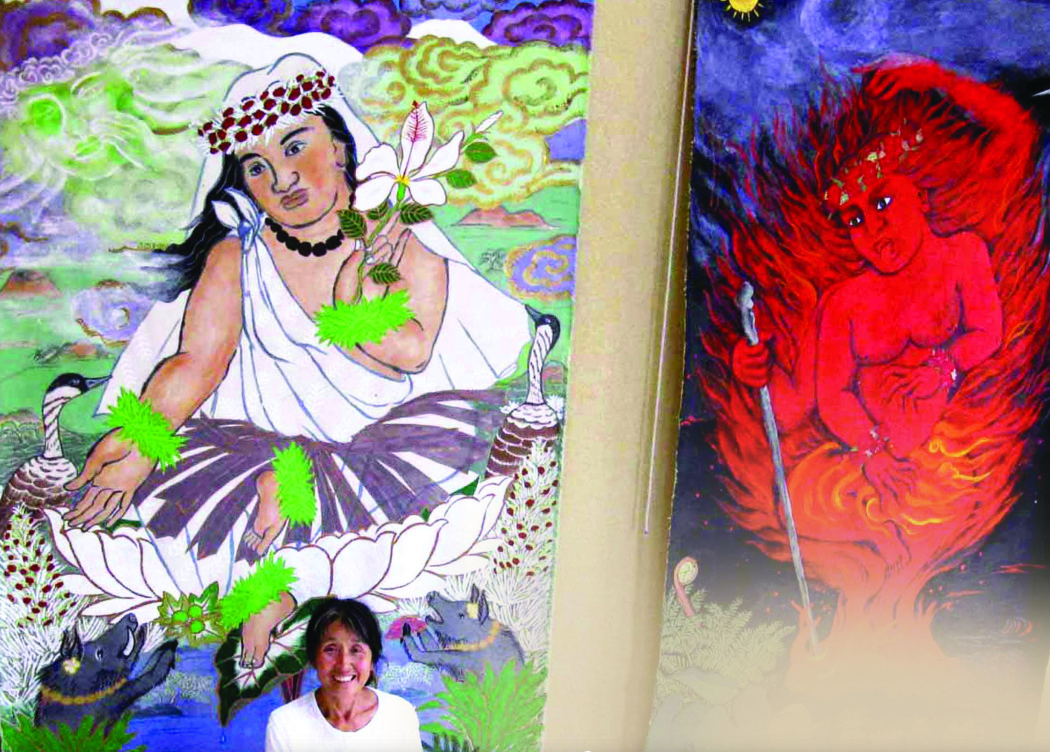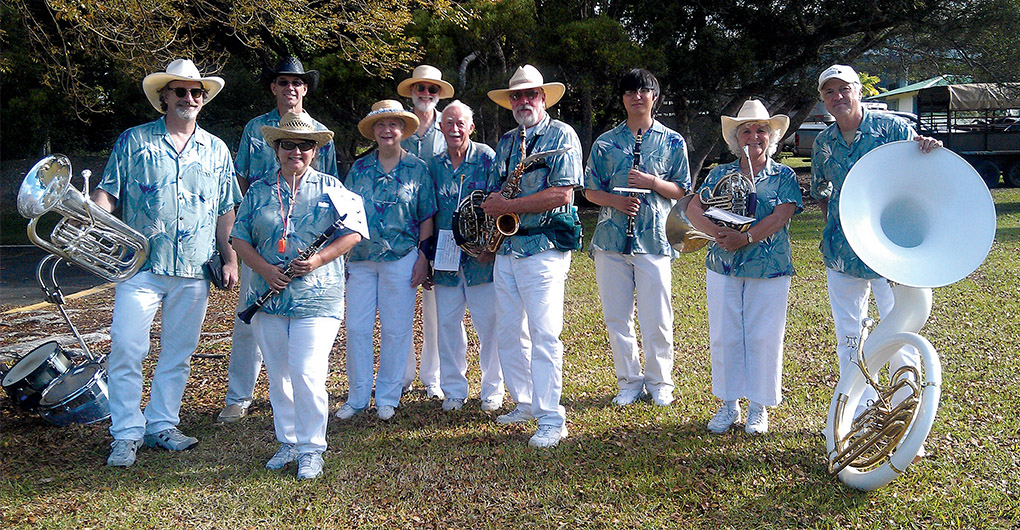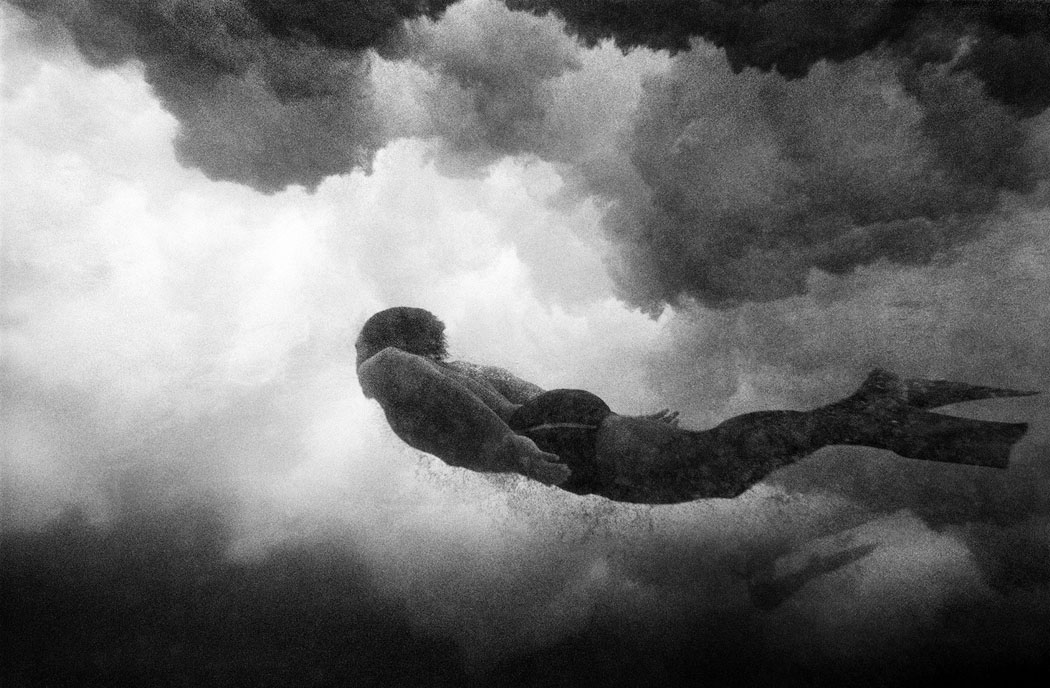
The Many Expressions of Mayumi Oda: The Goddess Garden Path to Saving the Planet
 By Marya Mann
By Marya Mann
“I just returned from Japan. I arrived there the day of the earthquake. I had traveled to Japan to visit a village where I had been asked to come and help create a Buddhist utopia.”–Mayumi Oda, Hawai‘i farmer, silkscreen artist and global activist.
Her voice sounds like a crystal bowl ringing out a call to breathe, to pay attention, to really see, and to act wisely on what we see. Mayumi Oda stands in her Kealakekua art studio describing her massive banner painting of Poli’ahu, whose very cloaks of snow adorned the volcanic peaks of the Big Island that April morning.
Pointing her arm like an arrow toward the peaks in her painting, the world-class artist, farmer, teacher, activist and educator says, “Poli’ahu is the goddess of the mountain Mauna Kea. She’s so high up so she can see through a lot of things. So beautiful.”
Mayumi—whose name means “beauty” and “true bow, used for archery”—has also seen through a lot of things. Under the vaulted ceiling of the main house at Ginger Hill Farm, with her portrayals of two Hawaiian goddesses behind her, she appears tiny but mighty, like a Zen breath. In her devotion to the splendor of life, Mayumi uses the fundamentals of line, shape and space to transform herself while gifting us with visual keepsakes, reminders of compassion, pleasure and utter reality, the unembellished truth.
Her playful paintings of a bicycling goddess, an undersea Sarasvati, impish Asian divinities and sensuous Hawaiian nature scenes, festooned with protective Shinto deities, dazzle the imagination, transcending boundaries of culture, race, religion and nationality. Through the awesome grace of these bountiful and bare-breasted deities, she has been able to face the awfulness of human endeavor that veers too far off the path of non-harming. When the atom is split and transformed from a source of life to a handmaiden of radioactive death, for instance.
“Earthship Green” depicts an “ultranatural” being with the Earth as her belly, an owl on her head, and a turtle and whale in the ocean below the ark she floats upon, which carries an elephant, snake and parrot among a cluster of creatures. A mantra-bearing flag and a full sail billows above it all, glistening under an observant sun.
“See, she also has a seed bag,” says Mayumi, pointing to the pouch the goddess holds in her right hand. But the Japanese silkscreen artist doesn’t want to talk about her painting today. She doesn’t care if you know she has mounted more than 40 one-woman shows, or that one Sumi-ink-on-washing-paper painting of hers can sell for five figures in Honolulu, or that her artwork is part of the permanent collections of the Museum of Modern Art in New York, the Museum of Fine Arts in Boston, Yale University Art Gallery in New Haven, and the Library of Congress in Washington D.C.
The aim of Mayumi’s life has a more expansive and long-range target.
From Hiroshima to a Plutonium-Free Future
Often called “the Matisse of Japan,” Mayumi’s art extends to the geo-political arena where she also works as a global activist, participating in anti-nuclear campaigns worldwide. In 1992, she founded Plutonium Free Future to help prevent another nuclear disaster. “For ten years, I worked so hard to make the Japanese government and people aware of the dangers of nuclear reactors,” she says. “But they built them all in a row, right on an earthquake fault. It’s craziness. When our group, with many other organizations, could not succeed at convincing the Japanese government and decision-making bodies that this threat was dire, I retired to Hawai‘i and started to farm.”
Mayumi’s quest to create a peaceful world began as a child while hiding in a backyard Tokyo bomb shelter and breathing in the sulfurous fumes of exploding bombs while American planes flew overhead. Shivering at the news of the nuclear bomb in Hiroshima, together with her grandfather and father, a Zen scholar and teacher, she feared for her life.
When she was four years old, she evacuated with her mother and brother to live in the north with their aunt and found the first real peace of her life. Her mother, an artist, taught her to draw mountains, saying to look at the mountain very carefully as she drew.
After the bombing of Hiroshima and Nagasaki, she watched the painful radiation burns appear on friends and neighbors, ravishing bodies, wracking them with pain. She saw up-close how the devastating radiation poisoning led to the slow hollowing out of the irradiated soul of her beloved homeland, and because she was willing to look carefully, the not-yet famous artist learned to see in a new way.
Learning to See
“The main thing I learned at University,” she says, “was to love the freedom and boldness of Japanese design.” Her patient drawings of live models at the Tokyo University of Art, where she majored in fabric dye and design, gave Mayumi a method of knowing her mind.
As she roamed the National Museum, among the screen paintings, lacquer ware, and brocaded designs from the Noh theater, she began to look beyond the traditional master-apprentice techniques of her formal study. In 1966, during the Vietnam War, she moved to New York City with her American husband, Japanese literature scholar John Nathan, met Allen Ginsberg, Timothy Leary, Mark Rothko and Willem de Kooning, and visited psychedelic light shows in a powerful process of self-discovery.
When she gave birth to her first child in 1967, Mayumi began to draw as a way to define herself and her changing body, and to see the way her paintings altered the views around her. She etched strong, black female images. Fertility motifs began to appear. “It was as if a sun inside me had finally broken through the cloud,” she says. “Goddesses became my theme.”
Her simple silkscreen technique, using a water-based glue and stencils, produces layering effects that invite steady lingering and deeper understanding of the actual view; the wonderful potency of her goddess visions comes from their ease and earthy transcendence. They’re both authentic, accessible and approachable.
More and More Beauty
The miracle of a plutonium free future is also accessible, rising up in our very backyards, manifesting at places like the visionary Ginger Hill Farm in Kealakekua. The circular form of the mandala-shaped vegetable gardens reflects respect for the full circle of life that produces healthy children, clean water, safe food and homes that are protected, and far away from the nuclear industry and its bed-partner, the weapons industry.
The edible gardens, meditation hall, studio and gathering center surround a bodhi tree, a descendent of the one that the Buddha sat beneath when he attained enlightenment. Another tree, a monkeypod that rises from the wrap-around deck overlooking the farm’s turmeric fields, is 80 years old. It looks like the mother tree in “Avatar.”
“We designed the house around the trees because they’ve been here longer than we,” says Mayumi, turning her eyes to glimpse the shaded monkeypod branches dripping nutritious seed pods, food for animals and children who like to chew on its licorice-flavored pods.
The garden is divided into sections representing the four cardinal directions and each section has seven beds for a total of 28 beds. “Growing my own food is a discipline that makes me very grounded,” says Mayumi. “It’s a mental discipline to tend something every day. Try to get your own calluses—it’s so beautiful.”
The men and women who practice, work the farm and study with Mayumi arise at dawn to salute the sun, giving beauty back to a world that regenerates and loves without limit.
Fukushima or Morokino? We Must Choose
On March 11, 2011, Mayumi Oda’s world shifted again. On the day of the 9.0 magnitude earthquake that triggered tsunami waves up to 125-feet high, Mayumi Oda had just landed in Japan.
“I had traveled to Japan to visit a village where I had been asked to come and help create a Buddhist utopia. This special village is in Morokino, the mythological birthplace of Shinto and Buddhism, only one hour from the well-known cities of Osaka and Nara.” Mayumi had just arrived in Morokino—in the Nara area where, coincidentally, she had gone during her childhood evacuation—when she heard news of the devastating earthquake.
The horror of radioactive leaks from Fukushima Nuclear Reactors came soon after.
For Mayumi and many of her clan, it felt like a flashback to August 6, 1945, when the U. S. government exploded an atomic bomb over Hiroshima, Japan. “Over 100,000 people were killed instantly,” according to the Safe Energy Handbook. Three days later, another atomic blast destroyed Nagasaki, immediately killing 70,000 people. “Many thousands more have since died from the ongoing effects of radiation poisoning.”
An earthquake-and-tsunami zone crowded with 127 million people was an unwise place for 54 nuclear reactors, says Rocky Mountain Institute Chief Scientist Amory Lovins. “The 1960s design of five Fukushima-I reactors has the smallest safety margin and probably can’t contain 90 percent of meltdowns. The U.S. has six identical and 17 very similar plants.”
As heroic workers try to save stricken Japan from this latest horror of radioactive fallout, it’s wise to remember that plutonium is the deadliest substance ever made by humans. A by-product of nuclear fission technology, it circulates around the globe and lands in desolate Arctic islands, on the tops of tall, New York buildings, on the grass meadows where Hilo cows graze, in a child’s milk, your neighbor’s lungs, your very blood.
It’s a dangerous way to generate electricity, and the plutonium required for nuclear energy can be diverted to make nuclear weapons.
But there’s another way.
“We don’t have to keep contaminating our precious, beautiful earth with radioactivity that will remain dangerous for hundreds of thousands of years,” says Mayumi.
The Choice for Aloha in Buddhist Utopias
“My goal was to bring Japanese people to my land on the Big Island to teach them how to farm and live sustainably—with a special hope that they could then help their own friends and families in Japan during a time of disaster. That time has unfortunately arrived.”
At Ginger Hill in Kona’s green belt, and possibly at Japan’s Morokino, she envisions Buddhist utopias where on-going relief efforts for earthquake and tsunami survivors can continue. Growing organic foods, in natural, contemplative living communities, will offer people healing, contentment, compassionate aloha, and the renewal of creativity.
To accomplish this goal, she co-founded a non-profit group called INOCHI, which is Japanese for “life force.” They have set up a special fund to receive donations to benefit the Morokino Project and another group called United Earth, a network of Japanese and overseas contacts doing direct aid in areas affected by disasters.
“These are people who have been working continuously since the Kobe earthquake in 1995,” says Mayumi. “When you give to them, you can know that your donation will actually reach the people who need assistance on the ground.” To raise money for Morokino and United Earth, Mayumi will give anyone donating $200 or more to INOCHI a special print of the limited edition masterwork, “Earthship Green.”
Looking for the connecting light between Mayumi’s light-hearted art—the Dakini sky dancers, surfing goddesses and deities riding fierce dragons—and her political mission to prevent nuclear suffering and global suicide from radiation poisoning, we discover it, like enlightenment, right in front of us.
Vivacious and animated, her banner paintings of Poli’ahu and Pele, queens of ice and fire, loom above us in her studio. The snow goddess Poli’ahu, depicted with pua‘a (pig), nene, silversword and cooling water where life-giving taro sprouts, caresses us with hope. In stillness, she endures with equanimity yet she acts fearlessly to cool down the explosive fires of Pele. In one Hawaiian story, Poli’ahu uses her persuasive skills and icy blasts of wind to sweep down the mountain, calming the furious flames of Pele.
While Pele’s flames are natural and necessary in creating a new earth, the lethal, suicidal, gene-modifying effects of radiation poisoning are up to no good at all.
“They have entered a bit too far into the sacred space of the Creator,” says the artist of those who tamper with the “demon core” of plutonium. Like Poli’ahu, she aims to dampen the fires of radiation with her gentle-mountain skills, reminding us there is a sacred, nurturing, healing presence within all of us. Sometimes we pause to admire the beauty. At other times, we might need to co-ordinate a World Court Project to make nuclear weapons illegal, as Mayumi did.
“As an artist, I want to bring that feeling of being a part of creation to my art. It takes your breath away and is a beautiful, comforting release to not be caught in fear,” she says. So now, when she isn’t touring to raise money for Japan relief work, she is back at work in her studio, and gardening, because, “As a farmer, one feels that we are completely part of creation, that we are just a small wave in the huge cosmos of ocean.”
In Hawai‘i, she has come back to “Gaia’s secret garden to nurture myself and my children,” she writes in her book, I Opened the Gate, Laughing. “I healed. I became whole.”
Now, 66 years after being bombed in Japan, she shares that healing experience with others, waking up a new generation with the power of her voice, the beauty of her vision, and the strength of her hands.
Every open heart who hears the ring of truth from the woman who sees and paints goddesses can aim toward the same target: a sane, healthy, loving planet.
You can help the Morokino project or United Earth. Donate now by sending checks made out to INOCHI and mail them to Mayumi Oda, Ginger Hill Farm, P.O. Box 1907, Kealakekua, HI 96750. Please specify on your donation which organization you want to support or indicate how much you would like to give for each. ❖
Visit Mayumi and check activities at her website: www.mayumioda.com.
Plutonium Free Future can be found at www.inochi.us. Visit their global library of nuclear issues and alternatives to a global culture of violence.
Ginger Hill Farm in Kealakekua can be reached at www.gingerhillfarm.com or by phoning 808.323.3964.
The Safe Energy Handbook (internet edition) illustrated by Mayumi, can be found at www.nonukes.org/safenrgy.htm
I Opened the Gate, Laughing is available at www.chroniclebooks.com.


